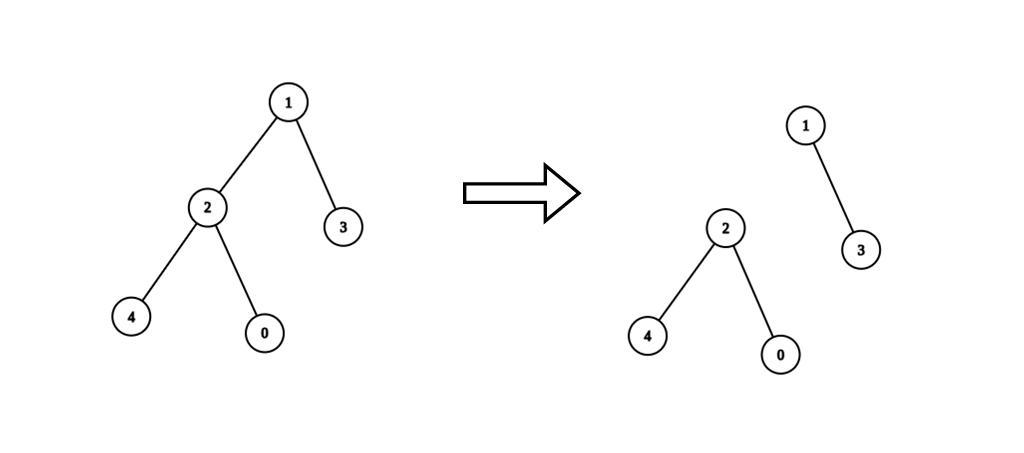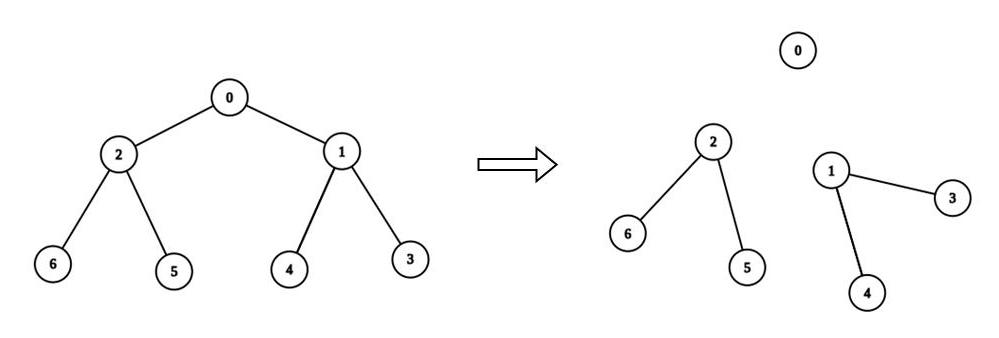可以被 K 整除连通块的最大数目
难度:
标签:
题目描述
There is an undirected tree with n nodes labeled from 0 to n - 1. You are given the integer n and a 2D integer array edges of length n - 1, where edges[i] = [ai, bi] indicates that there is an edge between nodes ai and bi in the tree.
You are also given a 0-indexed integer array values of length n, where values[i] is the value associated with the ith node, and an integer k.
A valid split of the tree is obtained by removing any set of edges, possibly empty, from the tree such that the resulting components all have values that are divisible by k, where the value of a connected component is the sum of the values of its nodes.
Return the maximum number of components in any valid split.
Example 1:

Input: n = 5, edges = [[0,2],[1,2],[1,3],[2,4]], values = [1,8,1,4,4], k = 6 Output: 2 Explanation: We remove the edge connecting node 1 with 2. The resulting split is valid because: - The value of the component containing nodes 1 and 3 is values[1] + values[3] = 12. - The value of the component containing nodes 0, 2, and 4 is values[0] + values[2] + values[4] = 6. It can be shown that no other valid split has more than 2 connected components.
Example 2:

Input: n = 7, edges = [[0,1],[0,2],[1,3],[1,4],[2,5],[2,6]], values = [3,0,6,1,5,2,1], k = 3 Output: 3 Explanation: We remove the edge connecting node 0 with 2, and the edge connecting node 0 with 1. The resulting split is valid because: - The value of the component containing node 0 is values[0] = 3. - The value of the component containing nodes 2, 5, and 6 is values[2] + values[5] + values[6] = 9. - The value of the component containing nodes 1, 3, and 4 is values[1] + values[3] + values[4] = 6. It can be shown that no other valid split has more than 3 connected components.
Constraints:
1 <= n <= 3 * 104edges.length == n - 1edges[i].length == 20 <= ai, bi < nvalues.length == n0 <= values[i] <= 1091 <= k <= 109- Sum of
valuesis divisible byk. - The input is generated such that
edgesrepresents a valid tree.
代码结果
运行时间: 173 ms, 内存: 34.9 MB
/*
* 思路:
* 1. 使用DFS和Java Stream来计算每个节点的子树值和,并检查是否可以被k整除。
* 2. 对于能被k整除的子树,增加连通块数。
*/
import java.util.*;
import java.util.stream.Collectors;
public class Solution {
public int maxKDivisibleComponents(int n, int[][] edges, int[] values, int k) {
// 构建图
Map<Integer, List<Integer>> graph = Arrays.stream(edges)
.flatMap(e -> Stream.of(Map.entry(e[0], e[1]), Map.entry(e[1], e[0])))
.collect(Collectors.groupingBy(Map.Entry::getKey, Collectors.mapping(Map.Entry::getValue, Collectors.toList())));
int[] sum = new int[n];
int[] res = new int[1];
boolean[] visited = new boolean[n];
// 从根节点0开始DFS
dfs(0, graph, values, k, sum, visited, res);
return res[0];
}
private int dfs(int node, Map<Integer, List<Integer>> graph, int[] values, int k, int[] sum, boolean[] visited, int[] res) {
visited[node] = true;
sum[node] = values[node];
for (int neighbor : graph.getOrDefault(node, Collections.emptyList())) {
if (!visited[neighbor]) {
sum[node] += dfs(neighbor, graph, values, k, sum, visited, res);
}
}
// 如果子树和可以被k整除
if (sum[node] % k == 0) {
res[0]++;
return 0;
}
return sum[node];
}
}解释
方法:
时间复杂度:
空间复杂度: